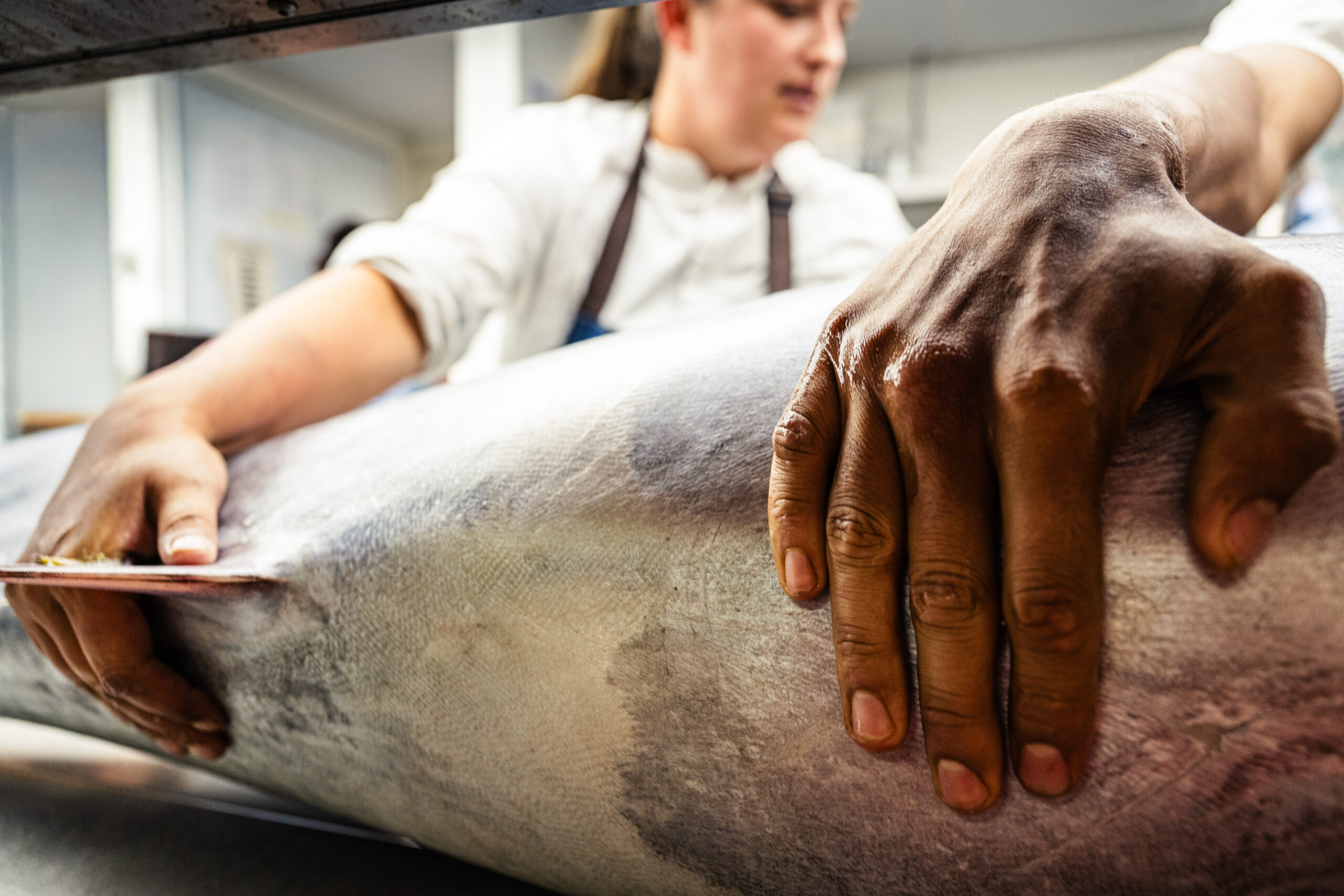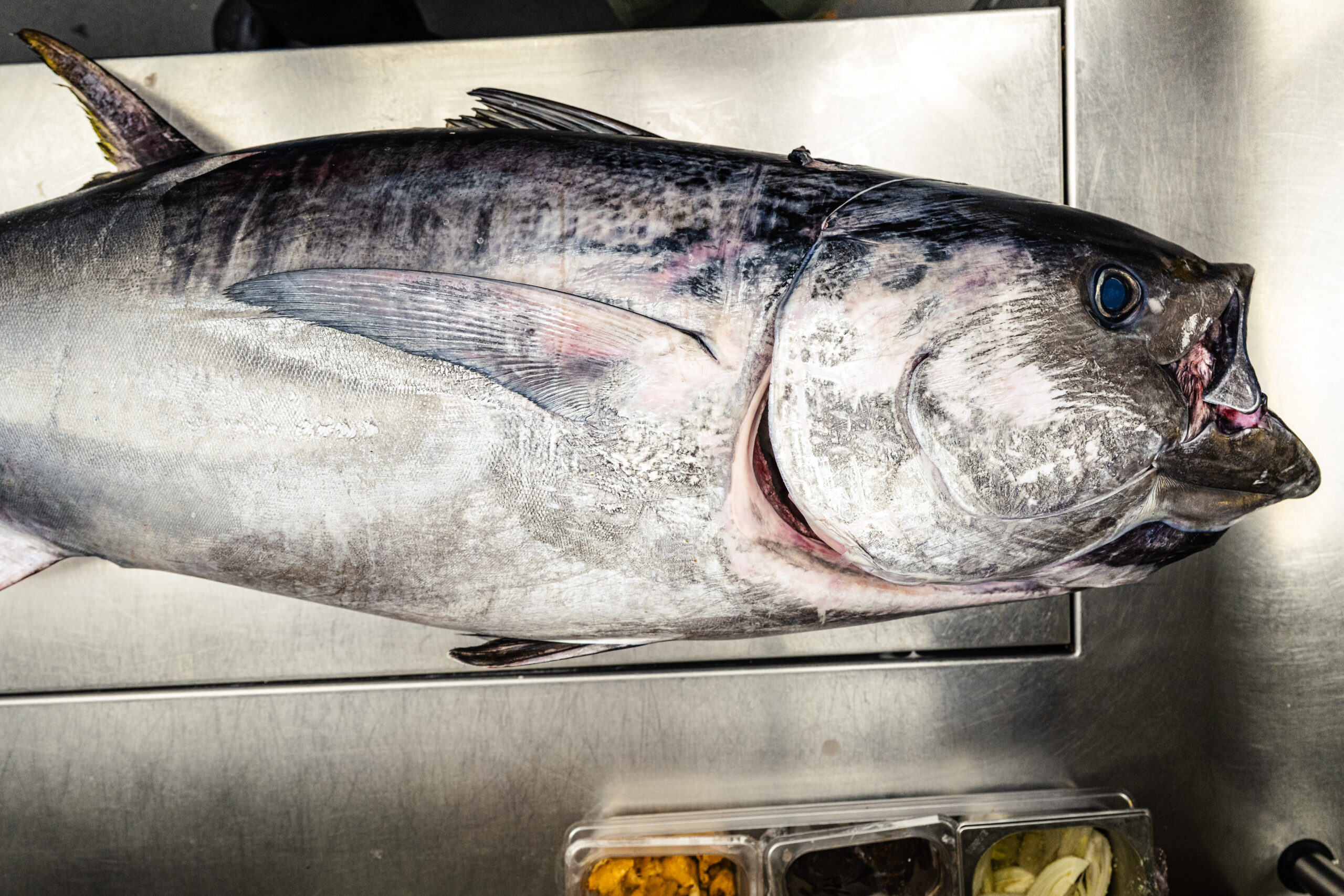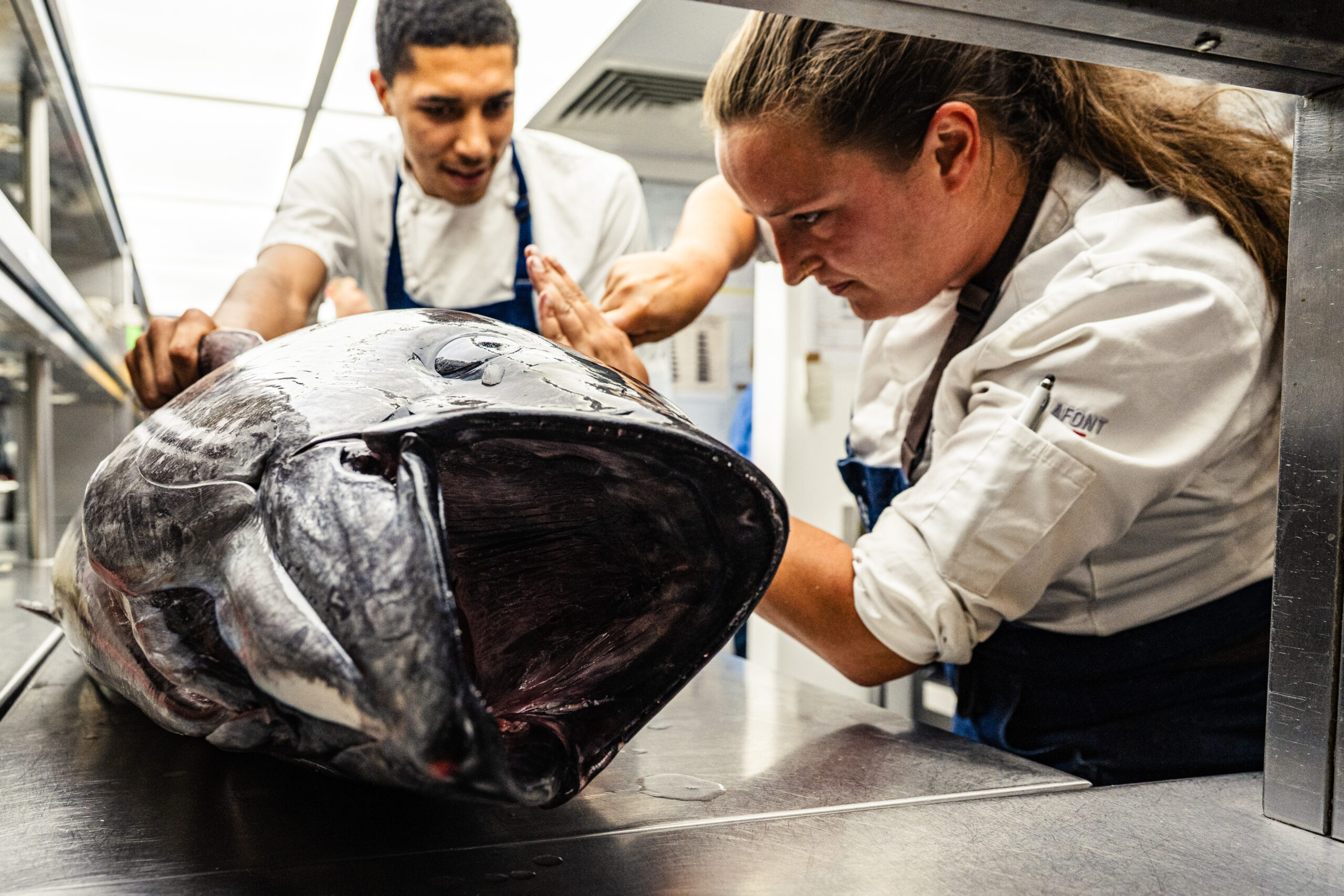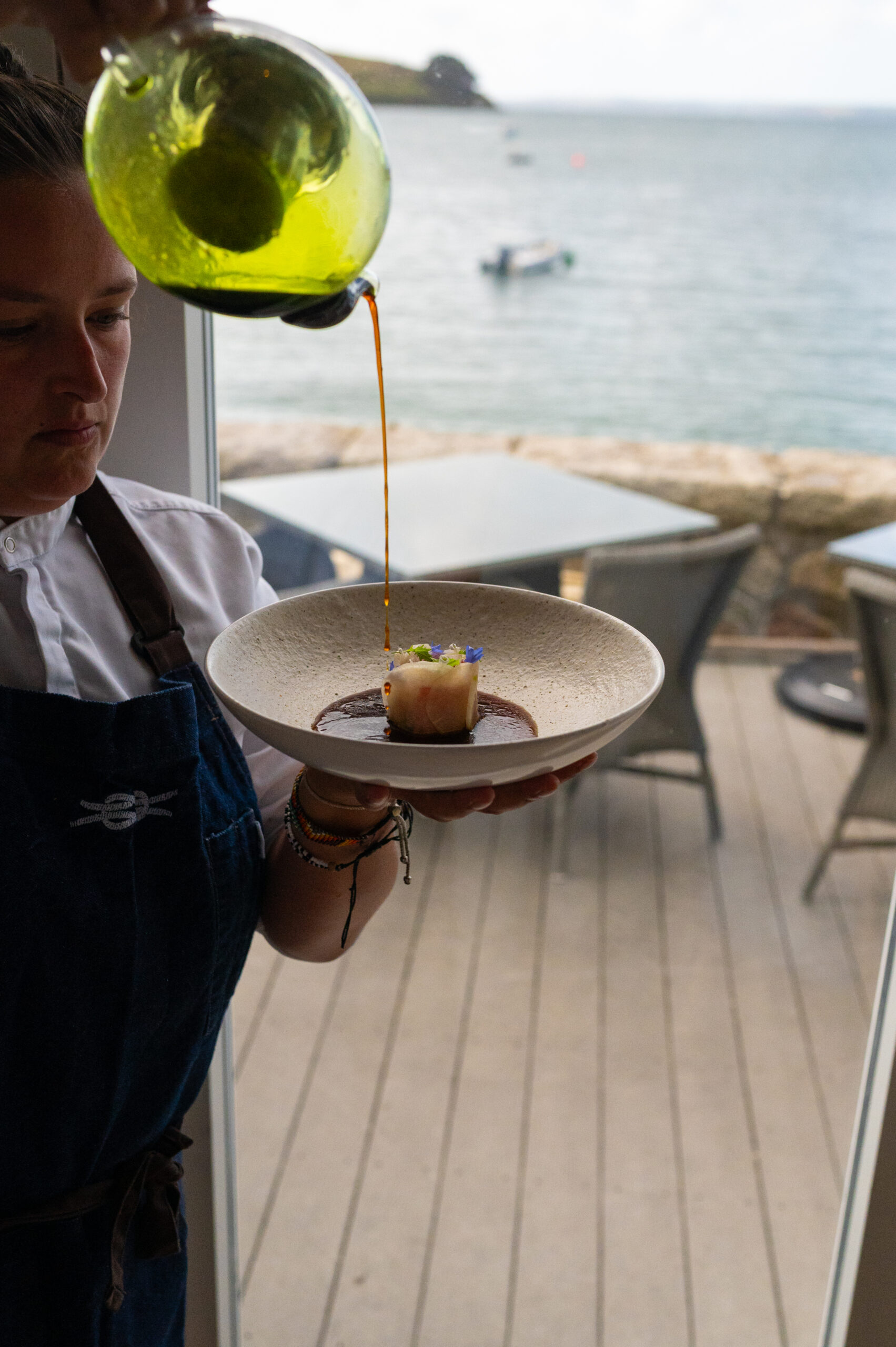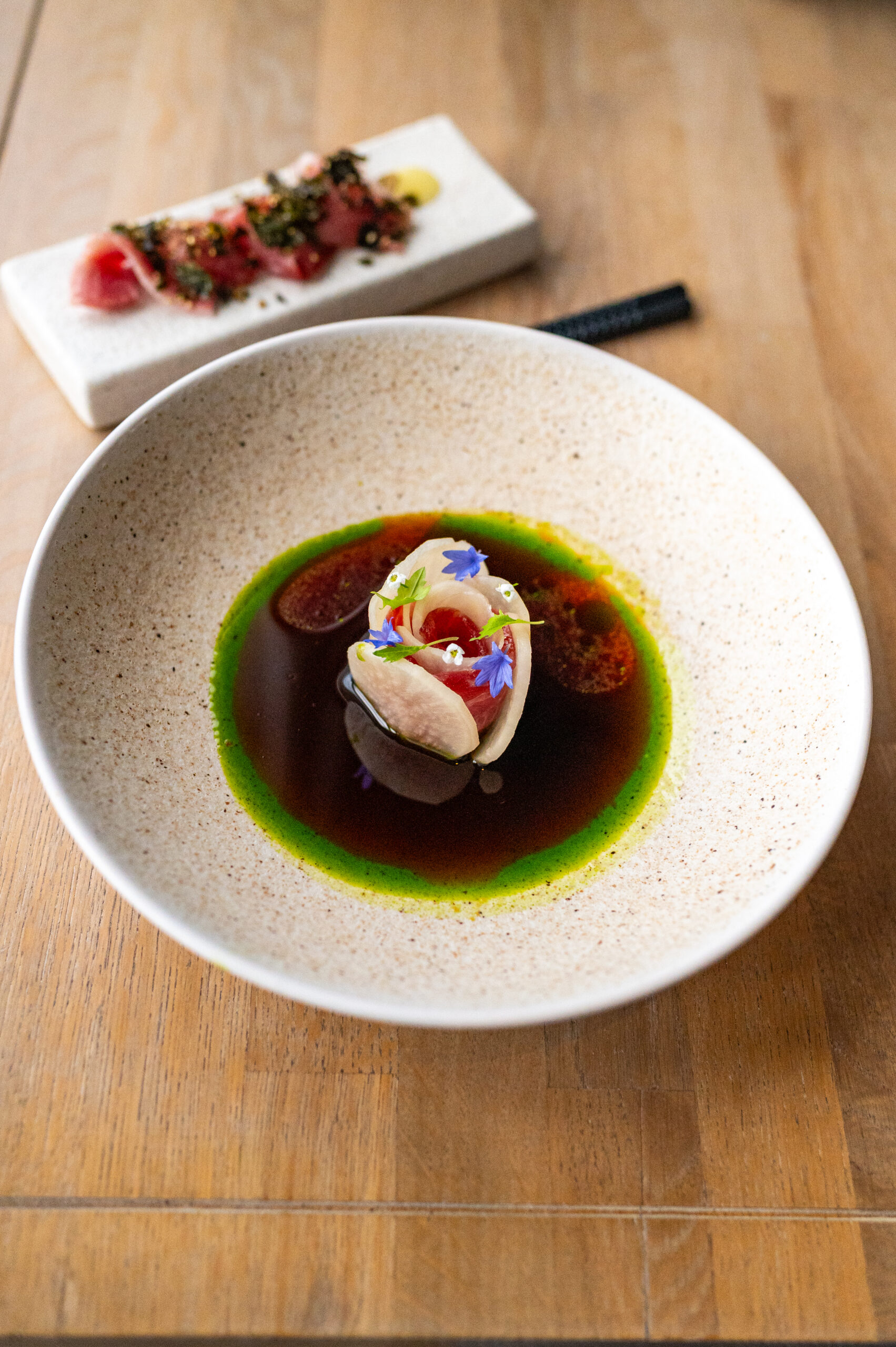Tue 14 Oct 2025
Plenty More (tuna)Fish with Carla Jones at The Idle Rocks
The call came through to Nik on a Tuesday evening. Carla Jones, head chef at The Idle Rocks in St Mawes – one of our boutique destination clients – had news: a line-caught 75kg bluefin tuna was on its way from a Newlyn day boat to their kitchen, and she invited us there to witness the fish being broken down for use across the menu.
In recent years, sightings of Atlantic bluefin off the Cornish coast have shifted from rare to regular. The species, absent from British waters since the 1960s after decades of overfishing, is now finding its way back into our seas and onto the menus of some of our favourite restaurants in and beyond Cornwall; Four Boys, OMA, The Sea, The Sea, Restaurant Mine, The Pig (Harlyn) and now The Idle Rocks. Its return is part of a complex, unfinished conversation: a tangle of ecological recovery, regulation, tradition and appetite. There is hope in seeing chefs work with a once-lost ingredient, but also a shared responsibility to the work of stewardship that ensures bluefin continue to thrive in our waters.
The next day we swapped our regular commute to cross the Roseland, fittingly by boat, before stepping into the kitchen to watch Carla and her team at work. After seeing them on the tools and tasting otoro straight from the spoon, Nik and Jasmin, our Copywriter and Creative Strategist, sat with Carla on the veranda overlooking the sea to talk about seasonality, sustainability and the joy of letting the sea dictate the menu.
So you’ve just received this incredible 75kg tuna, landed along the coast in Newlyn – what’s your feeling about getting a catch like this?
The feeling is incredible, it’s magical. Looking out to the sea and then being able to eat the fish here and use the produce that was literally caught a couple of miles away – there’s something so special about that in itself. Having the whole fish, like any whole animal, gets you thinking as a chef – what can you do with this cut? What can you do with that cut? There’s a real joy in demonstrating to the younger team members, who’ve probably never seen something like this before, how to break it down.
How do you plan on utilising the whole fish on your menu?
We have complete free rein of our menu here, and we like to stay true to the product and keep it really simple. There’s no point overcomplicating it. Currently we have a dish on the menu that’s served with a ponzu and a furikake. The ponzu is made with Roseland Market Garden tomatoes, which are sourced only two miles away as well, soy sauce and lots of citrus notes that really bring out the flavour of the tuna. We pair that with the fattiest cut, which is the otoro, because the citrus cuts through the fat beautifully. The prime cut from the loin we will serve completely raw as sashimi that compliments that dish.
To utilise everything, all the bones will be turned into garums or stocks. The garums take us about seven days to make – they go into a water bath and it’s a bit like making your own fish sauce. That will season all our sauces for the rest of the kitchen. We also have our sister restaurant at the St Mawes Hotel, so the tuna loins will be taken over to head chef there, Lee, for more classical preparations – he’s got a niçoise salad on at the moment so I can see it featuring there. We’ll keep some steaks here and put them on our plat du jour menu, served classically seared, maybe with a nice herb crust.
We’re seeing a lot more tuna than usual in local waters this year. Can you tell us a little about this?
To keep everything sustainable, a set number of licences are given out to fishermen each year – this year increasing to 15 from 13 in 2024 – the boat names are picked out of a hat, so you could have the licence this year but not get it next year. The stocks and licences are monitored closely by the Marine Management Organisation. Tuna fishing was banned for a number of years in Cornwall, so the fact that we’re allowed to do that now is incredible. Here at The Idle Rocks, we have the licence to buy completely direct off the tuna boats, which is great for us.
Who provided this particular tuna?
This beautiful line-caught 75kg tuna was landed by the Beryl M in Newlyn. Because of our close relationship with the fishers, we don’t have to wait for it to go up to London markets and then come back down. It’s so important to us as a restaurant as it keeps our food miles remarkably low. I personally think as a chef, and as a culture, everyone talks about sustainability – but we need to be more than sustainable now to make a change. The fact that we’re using a product caught less than five miles away, rather than it going 300 miles and then coming back, is really special.
Our in-house fisherman is Gareth Austin and his in-shore boat ‘Jodie-Ann’ which you can see on the harbour from the restaurant. Gareth goes out and fishes for us around the local area – mostly lobster and pot-caught scallops. He does a whole mackerel when they’re around and other bits and pieces. What is magical about this is that the sea dictates our menu. We don’t dictate the menu as chefs, because we honestly don’t know what’s going to come in.
With Gareth, he’ll text me after he’s been out at sea: “I’m on my way back, chef. Meet me at the bottom of the pontoon and this is what I’ve got for you.” We get the first pick of everything – fresh mackerel, beautiful scallops, massive lobsters, small lobsters. It’s incredible. We just take what we need rather than overfish and overkill.
What do you hope guests will take away from experiencing the tuna?
It’s funny, I was having a conversation this morning with the owner David about exactly this. He was out in Italy and there were some Australian people with him talking about Cornish tuna – the news of the quality of the product has reached as far away as Australia and they couldn’t wait to come to Cornwall and try it. It’s quite a sought-after product now. We’ll put this on the menu and it will fly out.
It’s becoming like how people come to try Porthilly oysters – Cornish tuna is getting that reputation. It’s only a short season that we get it, late summer to early autumn, so it’s a really short window. When it’s on the menu we need to shout about it.
It’s just such a magical product and such a short window of seasonality. We can celebrate the fact that we weren’t allowed to catch it before, and now the population is breeding again – it’s back in our waters. We must be doing something right from a fishing perspective for it to come back in such abundance. We were overfishing before, but now we’re seeing it return year on year because of the sustainable practices in place. We should shout more about how along the Roseland peninsula, and in Cornwall more broadly, local fishers are adhering to those rules and making tuna last forever rather than going extinct.
Our tasting menu is actually called “Plenty More Fish in the Sea.” The name signals that we’re taking responsibility and leaving enough for everyone else. This tuna will be a key part of that seafood tasting menu.
How long will it last on the menu?
We’ve had it on now for a couple of weeks, so we’ll probably only see it for another couple of weeks and then it’ll be done.
What’s the best way to book?
The tuna features on both our Plat du jour menu and our “Plenty More Fish in the Sea” tasting menu. Given the short season, I’d recommend booking soon to guarantee experiencing this incredible local product while it’s available.

